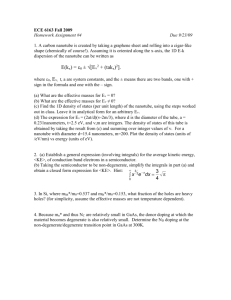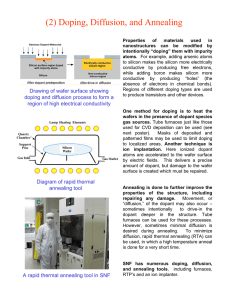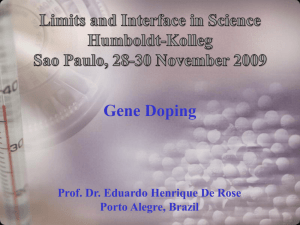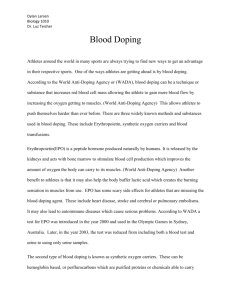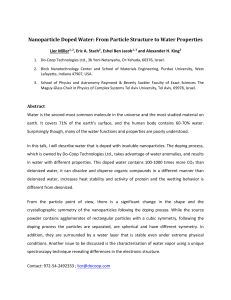Controlling doping and carrier injection in carbon nanotube transistors
advertisement
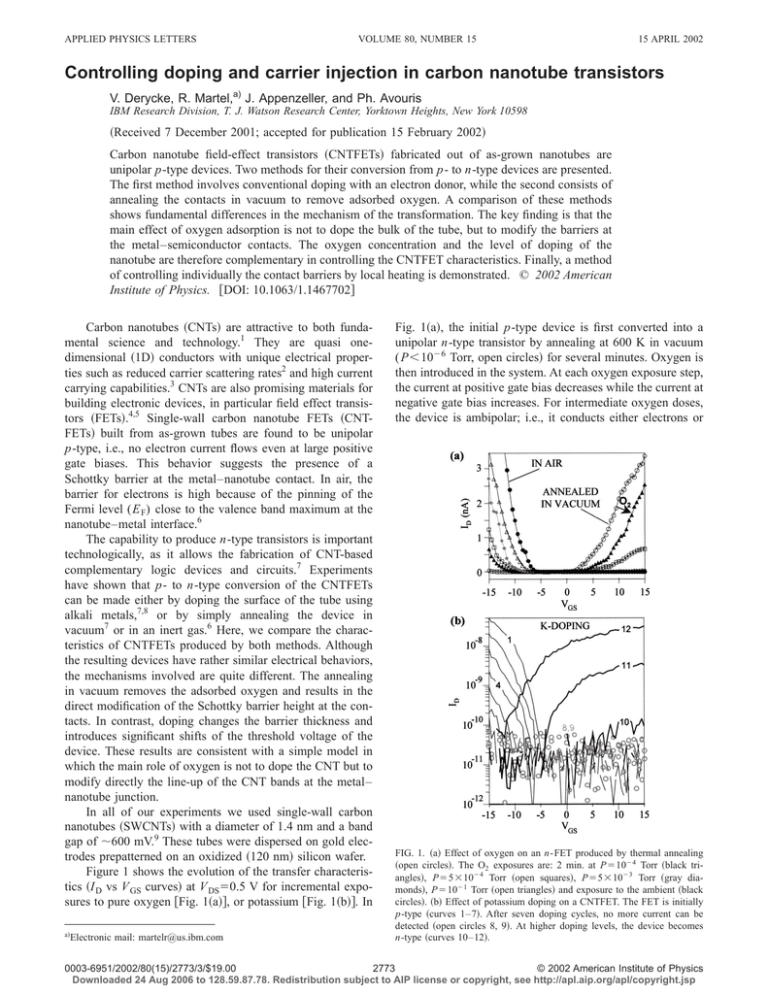
APPLIED PHYSICS LETTERS VOLUME 80, NUMBER 15 15 APRIL 2002 Controlling doping and carrier injection in carbon nanotube transistors V. Derycke, R. Martel,a) J. Appenzeller, and Ph. Avouris IBM Research Division, T. J. Watson Research Center, Yorktown Heights, New York 10598 共Received 7 December 2001; accepted for publication 15 February 2002兲 Carbon nanotube field-effect transistors 共CNTFETs兲 fabricated out of as-grown nanotubes are unipolar p-type devices. Two methods for their conversion from p- to n-type devices are presented. The first method involves conventional doping with an electron donor, while the second consists of annealing the contacts in vacuum to remove adsorbed oxygen. A comparison of these methods shows fundamental differences in the mechanism of the transformation. The key finding is that the main effect of oxygen adsorption is not to dope the bulk of the tube, but to modify the barriers at the metal–semiconductor contacts. The oxygen concentration and the level of doping of the nanotube are therefore complementary in controlling the CNTFET characteristics. Finally, a method of controlling individually the contact barriers by local heating is demonstrated. © 2002 American Institute of Physics. 关DOI: 10.1063/1.1467702兴 Carbon nanotubes 共CNTs兲 are attractive to both fundamental science and technology.1 They are quasi onedimensional 共1D兲 conductors with unique electrical properties such as reduced carrier scattering rates2 and high current carrying capabilities.3 CNTs are also promising materials for building electronic devices, in particular field effect transistors 共FETs兲.4,5 Single-wall carbon nanotube FETs 共CNTFETs兲 built from as-grown tubes are found to be unipolar p-type, i.e., no electron current flows even at large positive gate biases. This behavior suggests the presence of a Schottky barrier at the metal–nanotube contact. In air, the barrier for electrons is high because of the pinning of the Fermi level (E F) close to the valence band maximum at the nanotube–metal interface.6 The capability to produce n-type transistors is important technologically, as it allows the fabrication of CNT-based complementary logic devices and circuits.7 Experiments have shown that p- to n-type conversion of the CNTFETs can be made either by doping the surface of the tube using alkali metals,7,8 or by simply annealing the device in vacuum7 or in an inert gas.6 Here, we compare the characteristics of CNTFETs produced by both methods. Although the resulting devices have rather similar electrical behaviors, the mechanisms involved are quite different. The annealing in vacuum removes the adsorbed oxygen and results in the direct modification of the Schottky barrier height at the contacts. In contrast, doping changes the barrier thickness and introduces significant shifts of the threshold voltage of the device. These results are consistent with a simple model in which the main role of oxygen is not to dope the CNT but to modify directly the line-up of the CNT bands at the metal– nanotube junction. In all of our experiments we used single-wall carbon nanotubes 共SWCNTs兲 with a diameter of 1.4 nm and a band gap of ⬃600 mV.9 These tubes were dispersed on gold electrodes prepatterned on an oxidized 共120 nm兲 silicon wafer. Figure 1 shows the evolution of the transfer characteristics 共I D vs V GS curves兲 at V DS⫽0.5 V for incremental exposures to pure oxygen 关Fig. 1共a兲兴, or potassium 关Fig. 1共b兲兴. In a兲 Electronic mail: martelr@us.ibm.com Fig. 1共a兲, the initial p-type device is first converted into a unipolar n-type transistor by annealing at 600 K in vacuum ( P⬍10⫺6 Torr, open circles兲 for several minutes. Oxygen is then introduced in the system. At each oxygen exposure step, the current at positive gate bias decreases while the current at negative gate bias increases. For intermediate oxygen doses, the device is ambipolar; i.e., it conducts either electrons or FIG. 1. 共a兲 Effect of oxygen on an n-FET produced by thermal annealing 共open circles兲. The O2 exposures are: 2 min. at P⫽10⫺4 Torr 共black triangles兲, P⫽5⫻10⫺4 Torr 共open squares兲, P⫽5⫻10⫺3 Torr 共gray diamonds兲, P⫽10⫺1 Torr 共open triangles兲 and exposure to the ambient 共black circles兲. 共b兲 Effect of potassium doping on a CNTFET. The FET is initially p-type 共curves 1–7兲. After seven doping cycles, no more current can be detected 共open circles 8, 9兲. At higher doping levels, the device becomes n-type 共curves 10–12兲. 0003-6951/2002/80(15)/2773/3/$19.00 2773 © 2002 American Institute of Physics Downloaded 24 Aug 2006 to 128.59.87.78. Redistribution subject to AIP license or copyright, see http://apl.aip.org/apl/copyright.jsp 2774 Appl. Phys. Lett., Vol. 80, No. 15, 15 April 2002 FIG. 2. Schematic energy band diagram in the region of the metal-nanotube contact at V DS⫽0. 共a兲 Bands of the starting p-type device in air, 共b兲 the device after annealing in vacuum, 共c兲 a nanotube FET that is not out-gassed but is n-doped by potassium 关curves 8 and 9 of Fig. 1共b兲兴, and 共d兲 the same as in 共c兲 but at a higher doping level. W denotes the barrier thickness for electron injection. The examples in 共a兲 and 共b兲 are for an intrinsic nanotube. However, a low dopant level is expected to present a similar behavior. holes depending on the gate bias. At higher oxygen doses, the device is converted back into the original unipolar p-type device. This conversion from n-type to p-type with the intermediate ambipolar stages is fully reversible. The above results clearly show that the ambient gas is responsible for the observed p-type behavior in air. Now we concentrate on the p- to n-type conversion introduced by direct doping of the CNTFET with an electron donor. In Fig. 1共b兲, we show the evolution of the I D⫺V GS characteristics of a p-CNTFET upon doping with potassium. Twelve different curves are shown, corresponding to increasing doping levels. At low doping, the effect of potassium is to shift the curves toward more negative gate biases 共curves labeled 1–7兲. This behavior is typical for doping of a semiconductor.10 At intermediate doping 共open circles labeled 8 and 9兲, no current can be detected within the full range of gate biases. Electron conduction 共V GSⰇ0兲 becomes observable only for the highest doping levels 共curves 10 to 12兲. Further doping results in a shift of the curves to the left. Most importantly, no ambipolar behavior is seen in the range of gate biases used 共⫺15–15 V兲: the flat I – V curves extend over this full voltage range. This behavior is reproducible and is different from that produced by annealing 关Fig. 1共a兲兴. The behavior of the devices clearly indicates that the mechanisms for converting from p- to n-type are fundamentally different depending on the method of conversion. A simple phenomenological model 共Fig. 2兲 can describe the impact of barrier height and width at the metal–nanotube junctions as a function of the dopant level and the concentration of adsorbed oxygen. Initially, the nanotube is essen- Derycke et al. tially undoped and the p-type character of the device in air is due to the presence of a Schottky barrier that prevents electrons from being injected into the device. From this initial state, the band diagram evolves in two different ways as shown in Figs. 2共a兲 and 2共b兲 for the removal of oxygen, and as in Figs. 2共c兲 and 2共d兲 for n-doping with potassium. The effect of oxygen on the electrical properties of a nanotube device has previously been observed.11 In particular, an increase in the resistivity of nanotubes has been reported when they are brought from air to vacuum. In former studies, the effect associated with the adsorption of oxygen was assumed to involve doping.11–14 Doping implies a significant charge transfer from the nanotube to the adsorbed oxygen molecules. However, doping by oxygen cannot account for the experimental observations in Fig. 1共a兲 for several reasons. 共i兲 It does not explain the absence of electron conduction for large positive gate biases when the device is in air. Indeed, doping can, to a large extent, be compensated for by the gate field. The application of a sufficiently high positive gate bias should allow electron conduction, unless the hole doping level is extremely high. However, high doping levels are easy to detect since they lead to a significant current at zero gate bias, in contradiction to the measurements. 共ii兲 Assuming that the CNTs are p-doped by oxygen, its removal should therefore give intrinsic CNTs, not the observed n-type. Thus, the conversion of the CNFETs to make unipolar n-type devices is unaccounted for since it would require doping as well. 共iii兲 A change in the doping level should give rise to a shift in the threshold voltage of the transistor 关see Fig. 1共b兲兴. However, the gradual conversion in Fig. 1共a兲 from n- to p-type does not show any significant change in the threshold voltage. Charge transfer from the nanotube to the adsorbed gas can be present. It would lead to a shift of the Fermi level in the bulk of the tube. However, the interaction of O2 with a SWCNT is weak,15 and the charge transfer does not account for our experimental findings. The direct comparison with potassium doping in Fig. 1 shows striking differences. The main effect of out-gassing the device is rather consistent with a change in the barrier height at the contact. It implies that the pinning condition at the metal–CNT interface depends on the concentration of oxygen. The position of E F at this interface can change gradually within the band gap as a function of the concentration of oxygen. This effect changes the line-up of the bands at the interface but does not affect the bulk of the CNT. When E F at the junction is close to the center of the band gap, the barrier allows efficient tunneling, and ambipolar transport is observed.6 With gold contacts in air, only holes can be injected in the device 关Fig. 2共a兲兴, while after annealing, only electrons can be injected because the barrier is now too high for hole injection 关Fig. 2共b兲兴. In our model, the adsorption of oxygen at the contacts affects the local bending of the nanotube bands through charge-transfer and the dipole fields generated by the adsorbates. Analogous changes in field-emission barriers induced by adsorbates are well known.16 The case of doping with potassium is different. The depletion width, W, of a nanotube device at low doping levels is expected to depend exponentially on the inverse of the doping fraction.17 At large doping fractions, W is in the na- Downloaded 24 Aug 2006 to 128.59.87.78. Redistribution subject to AIP license or copyright, see http://apl.aip.org/apl/copyright.jsp Derycke et al. Appl. Phys. Lett., Vol. 80, No. 15, 15 April 2002 FIG. 3. 共a兲 I D(V GS) curves of a p-type FET in air for V DS⫽0.5 V and V DS⫽⫺0.5 V. 共b兲 Same in vacuum after a heating current has been passed through one of the contacts. 共c兲 Same after a second local heating step. 共d兲 Schematic of the contact design. nometer regime and it becomes possible for the electrons to tunnel through this barrier. This trend is totally consistent with the results at Fig. 1共b兲. The finding in Fig. 1共b兲 of flat I–V characteristics at intermediate doping levels clearly shows that doping involves changes in the width of the depletion region near the contacts. When the doping level of the nanotube is sufficiently high, a high negative gate bias is required to remove the high concentration of charges 共electrons兲 on the tube. Therefore, no hole conduction can take place 共up to at least V GS⫽⫺15 V兲. Furthermore, because of the pinning of the Fermi level at the valence band maximum, the resulting barrier is too high and wide to allow electron injection 关Fig. 2共c兲兴. Thus, there is no current at any gate bias. At even higher doping levels, the barrier becomes increasingly thinner because of the increased screening. In this regime, the device shows n-type characteristics as seen in the curves 10–12 of Fig. 1共b兲, as is illustrated in Fig. 2共d兲. If a highly potassium-doped CNTFET is exposed to oxygen, the curves revert to the initial p-type character following the same path without an ambipolar intermediate stage 共not shown兲. The oxygen oxidizes the adsorbed potassium atoms and therefore reduces the charge transfer from the potassium to the tube. This simple experiment again shows clearly that the effect of oxygen on an n-doped or an outgassed nanotube is different, revealing the difference in the mechanisms involved. Given that the Schottky barriers at the contacts can determine the device characteristics, gaining control of these barriers is very important. Next, we describe an experimental approach that allows a local control of the barrier height. Resistive contacts are used in place of the usual gold electrodes. These gold electrodes are connected at both ends and thinned down in the vicinity of the nanotube. With this design, it is possible to anneal separately each contact 共by passing a current兲 instead of annealing the complete device. Figure 3 presents this new electrode design as well as typical results. A CNTFET is first probed 关Fig. 3共a兲兴 in air for two 2775 opposite drain–source biases 共⫾0.5 V兲. The two curves correspond to hole conduction under forward and reverse bias conditions. Initially, the curves are symmetric. That is, the absolute value of the ratio between the current at V GS⫽⫾15 V is close to one 共R⫽0.94兲. The device is then placed in vacuum and a dc current is passed through one of the two contacts 关Fig. 3共d兲兴. Note that, after this treatment, 共i兲 both currents are smaller than in air, and 共ii兲 the curves are no longer symmetric, with one having almost twice as much current as the other 共R⫽1.8兲. A second step corresponding to a higher current through the same contact is displayed on Fig. 3共c兲. The ratio between the two curves is now close to five. The global decrease of the current indicates that the whole device is partially out-gassed by the heating of one contact. That implies some thermal conduction through the tube and thus a partial desorption of oxygen from the other contact. The drastic asymmetry in the I – Vs results from this nonuniform annealing, i.e., the directly annealed contact is much more affected by the heating. These results strongly support the importance of the contact barriers in determining the characteristics of the nanotube FETs. The behavior of the FETs can be fully understood in terms of the action of oxygen on the Schottky barriers without any assumptions concerning doping. Moreover, the new technique gives us a way to individually adjust these Schottky barriers. We thank B. Ek for expert technical assistance and J. Bucchignano for help with e-beam lithography. 1 Carbon Nanotubes: Synthesis, Structure Properties and Applications, edited by M. Dresselhaus, G. Dresselhaus, and Ph. Avouris 共Springer, Berlin, 2001兲. 2 C. T. White and T. N. Todorov, Nature 共London兲 393, 240 共1998兲; P. L. McEuen, M. Bockrath, D. H. Cobden, Y-G. Yoon, and S. G. Louie, Phys. Rev. Lett. 83, 5098 共1999兲; J. Appenzeller, R. Martel, Ph. Avouris, H. Stahl, and B. Lengeler, Appl. Phys. Lett. 78, 3313 共2001兲. 3 S. Frank, P. Poncharal, Z. L. Wang, and W. A. deHeer, Science 280, 1744 共1998兲; P. G. Collins, M. Hersam, M. Arnold, R. Martel, and Ph. Avouris, Phys. Rev. Lett. 86, 3128 共2001兲. 4 S. Tans, A. Verschueren, and C. Dekker, Nature 共London兲 393, 49 共1998兲. 5 R. Martel, T. Schmidt, H. R. Shea, T. Hertel, and Ph. Avouris, Appl. Phys. Lett. 73, 2447 共1998兲. 6 R. Martel, V. Derycke, C. Lavoie, J. Appenzeller, K. Chan, J. Tersoff, and Ph. Avouris, Phys. Rev. Lett. 87, 256805 共2001兲. 7 V. Derycke, R. Martel, J. Appenzeller, and Ph. Avouris, Nano Lett. 1, 453 共2001兲; X. Liu, C. Lee, C. Zhou, and J. Han, Appl. Phys. Lett. 79, 3329 共2001兲. 8 M. Bockrath, J. Hone, A. Zettl, P. L. McEuen, A. G. Rinzler, and R. E. Smalley, Phys. Rev. B 61, R10606 共2000兲. 9 A. Thess, R. Lee, P. Nikolaev, H. Dai, P. Petit, J. Robert, C. Xu, Y. H. Lee, S. G. Kim, A. G. Rinzler, D. T. Colbert, G. E. Scuseria, D. Tománek, J. E. Fischer, and R. E. Smalley, Science 273, 483 共1996兲. 10 S. M. Sze, Physics of Semiconductor Devices 共Wiley-Interscience, New York, 1981兲. 11 P. G. Collins, K. Bradley, M. Ishigami, and A. Zettl, Science 287, 1801 共2000兲. 12 G. U. Sumanasekera, C. K. W. Adu, S. Fang, and P. C. Eklund, Phys. Rev. Lett. 85, 1096 共2000兲. 13 K. Bradley, S-H. Jhi, P. G. Collins, J. Hone, M. L. Cohen, S. G. Louie, and A. Zettl, Phys. Rev. Lett. 85, 4361 共2000兲. 14 S-H. Jhi, S. G. Louie, and M. L. Cohen, Phys. Rev. Lett. 85, 1710 共2000兲. 15 D. S. Sorescu, K. D. Jordan, and Ph. Avouris, J. Phys. Chem. B 105, 11227 共2001兲. 16 R. Gomer, Field Emission and Field Ionization 共American Institute of Physics, New York, 1993兲. 17 F. Leonard and J. Tersoff, Phys. Rev. Lett. 83, 5174 共1999兲. Downloaded 24 Aug 2006 to 128.59.87.78. Redistribution subject to AIP license or copyright, see http://apl.aip.org/apl/copyright.jsp
